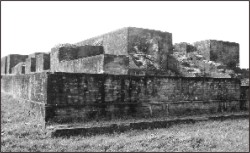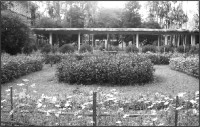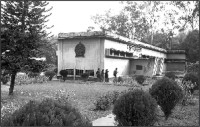| From Comilla
Revisiting Mainamati
Audity Falguni

THIS May, I rode the bus to Mainamati for the first time in six years. I had not seen the ancient kingdom of Samatata in so long. The archaeological museum of Mainamati displayed a number of Buddhist sculptures, artifacts, terracotta plaques, coins, utensils and manuscripts from the period between the 6th to 13th century AD.
In the museum I found the Assistant Custodian Mr. Sadequzzaman, who was my guide six years ago. I visited this area on a winter's day in 2003 and this year it was a mid-summer's day and I felt I had gotten exhausted just from the bus ride. The sun was blazing and there was a beautiful view of krishnachuras on the way. I was accompanied by Prothom Alo's Comilla Correspondent and the Assistant Custodian of the museum as I looked around.
 Mainamati Museum Today Mainamati Museum Today
There are 42 showcases displaying royal copper plates, 350 coins, bronze sculptures, stone sculptures, terracotta plaques and other terracotta objects, stone and metal objects, pottery and more. One particular copper plate is from Salban Bihara. It measures ten by eight inches, has writing on both its sides, on top it has a Dharmachakra (Wheel of Law), with two seated deer symbolising the first Sermon of Buddha in the Deer Park of Sarnath. After the copper plates, coins are the most important findings from the Mainamati excavations. Earliest are two gold coins belonging to the imperial Guptas, identified as the Asyamedha coin of Samudragupta (335-375 AD). The most recent coins found in the Kutila Mura excavation in 1957 belongs to the last Abbaside Caliph Abu Ahmed Abdullah Mustaasim Billah (1242-1258 AD). These give us evidence of trade between Arab countries and Bangladesh during the pre-Islamic period.
There are a large number of unbaked clay stupas encasing circular burnt clay ceilings inscribed with Buddhist creed. These were recovered in abundance from the Tri-ratna stupas of Kutila Mura. Among the clay figures the eight-handed Taras and Jamvalas are noteworthy. A large number of bronze sculptures were discovered from the Salban Bihara excavations, mainly the statutes of Buddha, Bodhisattva and Tara. These are excellent specimens of metal-casting and represent a mature art. These sculptures reveal a gradual change in Mahayana Buddhism in Bangladesh in the 7th and 8th centuries AD.
 The terracotta plaques are often the greatest source of excitement. Representations of men and women in war, warriors with swords and shields and archers with bows and arrows are noteworthy amongst the human representations. Besides these, flying female figures, amorous couple and acrobats are fairly common. Among birds, peacocks and swans are represented in different plaques. There is a swan holding a string of pearls and another eating the stem of a lotus. Terracotta plaques depicting animals include lions, horses, monkeys, wild boars, crocodiles and kirti-mukhas or two crouching lions. There are also fossilised woods, glass and shell objects and large-sized bricks at premises of the museum. The six largest sculptures in the museum are the black stone image of Heruka (a tantrik deity), a sandstone image of goddess Tara, the bronze head of a Buddhist image of Lokanatha, the image of Manjuvara in blackstone, the eight-armed black stone image of Marichi or the female counterpart of the meditative Buddha and the image of Ganesha, the Hindu God of wealth. The terracotta plaques are often the greatest source of excitement. Representations of men and women in war, warriors with swords and shields and archers with bows and arrows are noteworthy amongst the human representations. Besides these, flying female figures, amorous couple and acrobats are fairly common. Among birds, peacocks and swans are represented in different plaques. There is a swan holding a string of pearls and another eating the stem of a lotus. Terracotta plaques depicting animals include lions, horses, monkeys, wild boars, crocodiles and kirti-mukhas or two crouching lions. There are also fossilised woods, glass and shell objects and large-sized bricks at premises of the museum. The six largest sculptures in the museum are the black stone image of Heruka (a tantrik deity), a sandstone image of goddess Tara, the bronze head of a Buddhist image of Lokanatha, the image of Manjuvara in blackstone, the eight-armed black stone image of Marichi or the female counterpart of the meditative Buddha and the image of Ganesha, the Hindu God of wealth.

Outside the Museum: Archaeological spots under the open sky
As we come out of the museum, we follow the trail of red Krishnachura petals on red clay of the Lalmai hills to search for 23 archaeological sites of Mainamati. Finding all 23 might be a little too much for one day, but we can look at a few of the most important ones.
Salban Bihara (Site no. 12): Excavations since 1955 at the Salbanpur mound have revealed remains of a 550 square feet Buddhist monastery which was remade as Salban Bihara due to its proximity to the shal forest in the west. The big monastery, consisting of 115 cells, was built around a spacious courtyard with a shrine in the centre.
Kutila Mura (Site no. 4): Perched on a hillock, Kutila Mura is located about three miles north of Salban Bihara. On top of the hillock, within the enclosure, there are three stupas representing three jewels of Buddhism. This site measures about 280 feet from north to south and about 225 feet from east to west.
 Charpatra Mura (Site no. 19): Excavation on this mound has completely exposed the remains of a fairly large temple complex. It was renamed Charpatra Mura (hillock of four leaves) and belonged to the ancient Chandra kings. The ground plan of a large temple complex, measuring 105 feet east-west and 55 feet north-south, could be found here. Charpatra Mura (Site no. 19): Excavation on this mound has completely exposed the remains of a fairly large temple complex. It was renamed Charpatra Mura (hillock of four leaves) and belonged to the ancient Chandra kings. The ground plan of a large temple complex, measuring 105 feet east-west and 55 feet north-south, could be found here.
Ananada Raja's Palace (Site no. 5): This mound is situated about a mile north of the BARD complex at Kotbari, Comilla. It is more than 650 square feet in size and about 15 feet higher than the flat land. Local people call it Ananda Rajar Bari.
 Ranir Bungalow Mound (Site no. 20): Situated on the northernmost point of Mainamati hill, the mound is nearly 40 feet higher than the surrounding flat land. It is locally known as the palace and temple of Rani Mainamati, a well-known heroine in Bengali folk-literature. But why are cattle grazing here? Is there no one to look after this place? Ranir Bungalow Mound (Site no. 20): Situated on the northernmost point of Mainamati hill, the mound is nearly 40 feet higher than the surrounding flat land. It is locally known as the palace and temple of Rani Mainamati, a well-known heroine in Bengali folk-literature. But why are cattle grazing here? Is there no one to look after this place?
Challenges of the Mainamati Museum and other archaeological spots:
Despite the beauty of the Mainamati museum and other archaeological spots, overall it lacks proper maintenance and care. “Problems are many. We have a manpower crisis” said Mr. Sadequzzaman, Assistant Custodian of the Mainamati Museum who has been working here since 1999.
 “Although the museum earns around Tk. 1,50,000-2,10,000 per month from ticket sales, this is really not enough to maintain, renovate and excavate the archaeological sites and the museum. The Department of Archaeology and Ministry of Culture helps us. Still, we need more financial support to excavate further and renovate in a more modernised way,” he commented. “Although the museum earns around Tk. 1,50,000-2,10,000 per month from ticket sales, this is really not enough to maintain, renovate and excavate the archaeological sites and the museum. The Department of Archaeology and Ministry of Culture helps us. Still, we need more financial support to excavate further and renovate in a more modernised way,” he commented.
“We are hopeful that the number of visitors is will increase. In summer (1st April to 30th September) the museum remains open from 10:00 am to 6:00 pm with a half hour lunch break. It is closed on Sundays. In winter (1st October to 31st March), the museum remains open from 9:00 am to 5:00 pm.” he added.
References:
A.K.M.Shamsul Alam, Mainamati, Department of Archaeology and Museum, 1976
Md. Shafiqul Alam, Excavation at Rupbanmura, Department of Archaeology, 2000
Copyright
(R) thedailystar.net 2009
|
